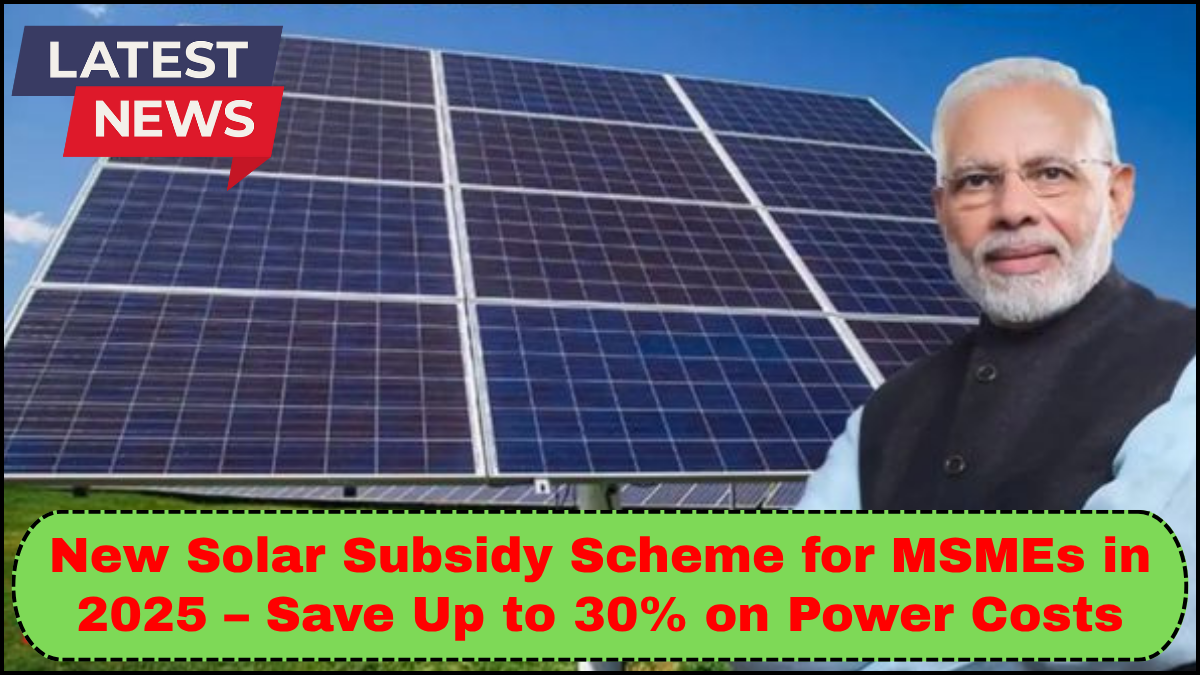In a significant step towards driving clean energy adoption and reducing operational overheads, the Indian government has rolled out the Govt Solar Subsidy Scheme for MSMEs 2025. This initiative is tailored to help Micro, Small, and Medium Enterprises (MSMEs) transition to solar energy while slashing electricity bills by up to 30%.
This policy shift is not just about green power—it’s a calculated move to make MSMEs more competitive by easing one of their biggest expenses: energy.

What is the Govt Solar Subsidy Scheme for MSMEs 2025?
The Govt Solar Subsidy Scheme for MSMEs 2025 is a government-backed initiative offering financial assistance to eligible businesses to install rooftop solar panels. The scheme aims to boost renewable energy usage among MSMEs and curb reliance on grid electricity.
The subsidy covers a percentage of the capital cost of installing solar systems, making solar energy more affordable. Depending on location, scale, and energy consumption patterns, MSMEs can receive up to 40% subsidy on installation costs, with projected electricity bill reductions of 25% to 30%.
Why the Focus on MSMEs?
MSMEs are the backbone of the Indian economy, contributing nearly 30% to the GDP and employing over 110 million people. Despite their economic significance, most MSMEs struggle with high energy costs, inconsistent power supply, and rising tariffs.
The 2025 energy subsidy targets these exact pain points, offering a scalable, sustainable alternative to conventional electricity.
By promoting MSME solar power, the government aims to:
-
Lower energy expenses for small businesses
-
Improve energy reliability in semi-urban and rural industrial zones
-
Support the country’s net-zero goals by increasing non-fossil fuel usage
Key Features of the 2025 Solar Subsidy Scheme
1. Capital Subsidy Structure:
MSMEs can claim up to 40% subsidy for rooftop solar installations up to 3 kW, and 20%–25% for systems up to 10 kW. Larger installations may qualify under net metering policies, though with adjusted rates.
2. Simplified Application Process:
The scheme has a streamlined digital application via the Ministry of New and Renewable Energy (MNRE) portal. Applicants can track status, connect with approved vendors, and access guides for compliance.
3. Vendor Empanelment:
Only registered and MNRE-approved solar vendors are eligible to participate, ensuring quality installations and standardized pricing.
4. Net Metering Benefits:
MSMEs can offset power bills further by selling excess electricity generated back to the grid. This not only reduces the payback period but also boosts long-term ROI.
5. Financing Support:
Banks and NBFCs are offering low-interest loans with repayment options up to 10 years, backed by government risk guarantees.
Long-Term Savings and Business Benefits
The immediate financial appeal is evident—up to 30% power cost savings annually. But the long-term advantages go deeper:
-
Improved credit profile: Lower operational costs improve business margins and creditworthiness.
-
Energy independence: Less reliance on fluctuating grid rates shields businesses from future tariff hikes.
-
Brand positioning: Green operations can enhance market reputation, especially for export-focused firms where sustainability is a selling point.
State-Level Add-Ons and Incentives
While the central government is driving the scheme, many states have announced additional energy subsidy 2025 offers. For example:
-
Maharashtra offers extra incentives for industries in designated green clusters.
-
Gujarat provides faster clearances and additional land allotment benefits for solar-powered MSMEs.
-
Tamil Nadu and Rajasthan offer extra subsidies for installations by women-led or SC/ST-owned enterprises.
These localized benefits can stack with the national subsidy, further lowering investment thresholds.
Challenges and How to Overcome Them
Despite the lucrative incentives, some MSMEs hesitate due to concerns about:
-
Initial capital investment: Even with subsidies, upfront costs can feel high. Solution: leverage soft loans and EMI options supported by the scheme.
-
Technical complexity: Not all businesses understand solar sizing, site assessment, or grid connection. Solution: use empaneled vendors who offer turnkey solutions.
-
Space limitations: Many MSMEs operate from leased or small premises. Solution: explore community solar projects or shared rooftop installations.
Final Thoughts
The Govt Solar Subsidy Scheme for MSMEs 2025 is more than a policy—it’s a strategic opportunity. For MSMEs struggling with tight margins and rising energy bills, switching to solar is now not only feasible but financially smart.
Adopting MSME solar power solutions under this scheme is an investment in resilience, growth, and sustainability. As energy prices climb and environmental standards tighten globally, early movers in this space will have a competitive edge.
FAQs
Q1. Who is eligible for the Govt Solar Subsidy Scheme for MSMEs 2025?
MSMEs registered under UDYAM with a valid GST and electricity connection are eligible. The unit must be operational and located in an area approved under the scheme.
Q2. How much subsidy can I get on a solar system?
Up to 40% for systems up to 3 kW and up to 25% for systems up to 10 kW, depending on state policies and site conditions.
Q3. How do I apply for the scheme?
Applications can be submitted online through the MNRE’s official portal. Required documents include UDYAM registration, electricity bill, and site photographs.
Q4. Can I still participate if my premises are rented?
Yes, with landlord permission. Some states have guidelines for leased properties to promote shared solar solutions.
Q5. How long will it take to see returns on investment?
With subsidies and net metering, most MSMEs see a full ROI within 3 to 4 years, followed by nearly free power for over a decade.
click here to learn more


